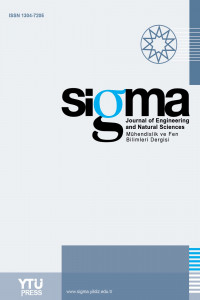REMOVAL OF Co(II) AND Se(VI) FROM RAW METAL AND GLASS INDUSTRY WASTEWATERS USING NANO-SiO2 / ZrO2-CALCIUM ALGINATE AEROGELS
Abstract
By doping ZrO2 to the SiO2 with aerogel; the Co(II) and Se(VI) from metal and glass industry wastewaters can be removed due their large surface area and high pore volume. For maximum Se(VI) and Co(II) adsorptions (99% and 96%) the optimum Nano-SiO2 / ZrO2-Calcium Alginate Aerogel composite concentrations was found as 4 mg/l, at a pH of 6.0 at a temperature of 80 0C after 45 min contact time. Nano-SiO2 / ZrO2-Calcium Alginate Aerogel were reused with the percentages of 83 % and 87% for Co(II) and Se(VI), respectively after four sequential utilisation. This reduce the treatment cost by 38%.
Keywords
Co(II) Se(VI) Metal Industry Wastewater Glass Industry Wastewater Adsorption Nano-SiO2 / ZrO2-Calcium Alginate Aerogel Reuse Cost
References
- [1] S. Lawson, J.M.Macy, (1995) Bioremediation of selenite inoil refinerywastewater, Appl. Microbiol. Biotechnol. 43 (4) 762–765.
- [2] D. Peak, (2006) Adsorption mechanisms of selenium oxyanions at the aluminum oxide/water interface, J. Colloid Interface Sci. 303 337–345.
- [3] J. Das, D. Das, G.P. Dash, K.M. Parida, (2002) Studies on Mg/Fe hydrotalcite-likecompound (HTlc). I. Removal of inorganic selenite (SeO32−) from aqueous medium, J. Colloid Interface Sci. 251 (1) 26–32.
- [4] M. Duc, G. Lefèvre, M. Fédoroff, (2006) Sorption of selenite ions on hematite, J. Colloid Interface Sci. 298 (2) 556–563.
- [5] A. Afkhami, (2002) Kinetic-spectrophotometric determination of selenium in natural water after preconcentration of elemental selenium on activated carbon, Talanta 58, 311–317. http://doi.org/10.1016/S0039-9140(02)00246-1.
- [6] E.I. El-Shafey, (2007) Removal of Se(IV) from aqueous solution using sulphuric acidtreated peanut shell, J. Environ. Manage. 84, 620–627.
- [7] M. Martínez, J. Giménez, J. de Pablo, M. Rovira, L. Duro, (2006) Sorption of selenium (IV) and selenium (VI) onto magnetite, Appl. Surf. Sci. 252 (10) 3767–3773.
- [8] T. Kokubo, (1991) Bioactive glass ceramics: properties and applications, Biomaterials 12 155–163.
- [9] W.H. Tuan, J.R. Chen, C.J. Ho, (2008) Critical zirconia amount to enhance the strength of alumina, Ceram. Inter. 34 2129e2133.
- [10] Y.Y. Lyu, S.H. Yi, J.K. Shon, (2004) Highly stable mesoporous metal oxides using nanopropping hybrid gemini surfactants, J. Am. Chem. Soc. 126 2310e2311.
- [11] Prabha Dubey, Shashi, Dhar Dwivedi, Amarendra, Kim, In-Chul, Sillanpaa, Mika, Kwon, Young-Nam, (2014) Synthesis of graphene–carbon sphere hybrid aerogel with silver nanoparticles and its catalytic and adsorption applications, Chem. Eng. J. 244, 160-167.
- [12] Qina, Guotong, Yao, Yuan, Wei, Wei, Zhang, Tao, (2013) Preparation of hydrophobic granular silica aerogels and adsorption of phenol from water. Appl. Surf. Sci. 280, 806-811.
- [13] S.Jr. Swann, E.G. Appel, S.S. Kistler, (1934) Thoria aerogel catalyst: aliphatic esters to ketones Ind, Eng. Chem. 26 (1934). 1014–1014.
- [14] M. Adebajo, R. Frost, J. Kloprogge, O. Carmody, S. Kokot, (2003) Porous materials for oil spill cleanup: a review of synthesis and absorbing properties, J. Porous Mater. 10 159–170.
- [15] J.W. Long, A.E. Fischer, T.M. McEvoy, M.E. Bourg, J.C. Lytle, D. Rolison, (2008) Selflimiting electropolymerization en route to ultrathin, conformal polymer coatings for energy storage applications, PMSE Prepr. 99 772–773.
- [16] S.S. Latthe, Y.N. Digambar, A.V. Rao, (2009) TMOS based water repellent silica thin films by co-precursor method using TMES as a hydrophobic agent, Appl. Surf. Sci. 255 3600–3604.
- [17] Junchuan Zhao, Xingeng Ding, Cheng Meng, Chunrong Ren, Huiqin Fu, Hui Yang, Adsorption and immobilization of actinides using novel SiO2eZrO2-calcium alginate aerogels from high level liquid waste http://dx.doi.org/10.1016/j.pnucene.2015.09.006.
- [18] Mohammad Reza Jamali, Bahram Soleimani, Reyhaneh Rahnama,Seyed Hojjat Allah Rahimi, Development of an in situ solvent formation microextraction and preconcentration method based on ionic liquids for the determination of trace cobalt (II) in water samples by flame atomic absorption spectrometry, http://dx.doi.org/10.1016/j.arabjc.2012.08.004.
- [19] Y Caiping, Adsorption and desorption properties of D151 resin for Ce(III) (2010)Journal of rare earths, Vol. 28, Spec. Issue, Dec. 2010, p. 183 DOI: 10.1016/S1002-0721(10)60324-9.
- [20] S. Somiya, N. Yamamato, H. Yanagina, (1988) Science and Technology of Zirconia (III), vol. 24A and 24B, American Ceramic Society, Westerville.
- [21] T. Matias, J. Marques, M.J. Quina, L. Gando-Ferreira, A.J.M. Valente, A. Portugal, L. Durães, (2015) Silica-based aerogels as adsorbents for phenol-derivative compounds, Colloids Surf. A 480 (2015) 260–269.
- [22] Lu-hua Jiang, Yun-guo Liu, Guang-ming Zeng, Fang-yu Xiao, Xin-jiang Hu, Xi Hu, Wang Hui, Li Ting-ting, Zhou Lu, Tan, Removal of 17β-estradiol by few-layered graphene oxide nanosheets from aqueous solutions: External influence and adsorption mechanism, Xiao-fei, Chem. Eng. J. 284 (2016) 93–102., http://doi.org/10.1016/j.cej.2015.08.139.
Details
| Primary Language | English |
|---|---|
| Subjects | Engineering |
| Journal Section | Research Articles |
| Authors | |
| Publication Date | March 1, 2018 |
| Submission Date | November 16, 2017 |
| Published in Issue | Year 2018 Volume: 36 Issue: 1 |
IMPORTANT NOTE: JOURNAL SUBMISSION LINK https://eds.yildiz.edu.tr/sigma/


